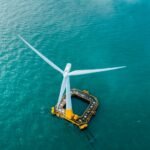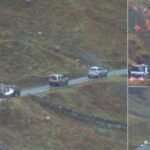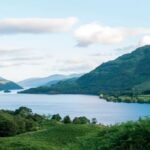Hidden off the western coast of Scotland, the Isle of Staffa has long enchanted visitors with its eerie rock formations, mythical cave acoustics, and untouched beauty. Though barely a blip on the map, it holds a rare mix of geology, music, and legend that refuses to be forgotten.
Small. Isolated. But unforgettable.
Fingal’s Cave: Music, Majesty and Stone
It’s not just a hole in the cliff. It’s a cathedral sculpted by lava.
Fingal’s Cave is the crown jewel of Staffa, with towering basalt columns that rise like pipes in a frozen organ. What makes it more surreal? The sound. Waves echo through the cave like a symphony warming up, which isn’t just poetic—it actually inspired one.
Felix Mendelssohn visited in 1829. He wasn’t looking for inspiration, but Staffa had other plans. Just weeks later, the German composer penned the Hebrides Overture, trying to capture what he heard in that cave. He came for scenery and left with a melody.
Queen Victoria didn’t need music to be moved. When she visited, she called the cave “extraordinary and splendid,” writing about the surreal colors that danced along the wet stone—blues, greens, even flashes of pink. She was the first British monarch to step foot on Staffa. That’s no small thing.
Today, visitors can walk right up to the cave via a cliffside trail. It’s narrow. It’s slippery. And yet—completely worth it.

Born from Fire: A Landscape Shaped by Violence
Staffa wasn’t gently formed. It was forged in fire—literally.
About 60 million years ago, volcanic eruptions ripped through the Earth’s crust. Lava poured out, cooled rapidly, and cracked into columns that now make up the island’s signature design. The result? A landscape that looks like it belongs on another planet.
It’s not just Fingal’s Cave either. The whole island is made up of these bizarre, hexagonal pillars. They stack and lean like dominoes frozen mid-collapse. You can’t walk more than a few steps without being reminded that this place was born from chaos.
And here’s the kicker—it’s not alone. These same volcanic formations connect Staffa geologically to the Giant’s Causeway in Northern Ireland and parts of Iceland. Nature had a pattern going.
Just one sentence here: It’s one of the few places on Earth that looks manmade but is entirely natural.
A Sanctuary for Puffins, Silence and Scientists
While most people come for the rock formations, some stay for the birds—or at least try to.
Staffa has no permanent human residents. But during the summer, it becomes home to puffins. Dozens, sometimes hundreds, nest along the grassy cliffs. They’re curious little things, often waddling close to visitors with a mix of confidence and confusion.
Biologists adore Staffa, not just for its birdlife, but its unique ecosystem. Since the island is uninhabited, it’s been allowed to evolve with minimal human interference.
-
Puffins, fulmars, and shags nest along the cliff edges
-
Seals can often be seen basking on lower rocks
-
The surrounding waters are rich with porpoises and dolphins
A single narrow footpath crosses the island, winding through sea-pinks and short grasses. That’s it. No roads. No buildings. Just nature doing its thing.
And every once in a while, a marine biologist or geologist shows up to take notes, collect samples, and marvel at what still thrives here.
A Timeline That Stretches Back to Vikings and Botanists
Staffa isn’t just about lava and birds. It’s steeped in stories.
The name “Staffa” actually comes from the Old Norse word for “pillar.” Vikings spotted the tall rock formations and figured it looked like a forest of stone columns.
The island stayed mostly out of the spotlight until 1772, when Joseph Banks—a famous botanist—visited and raved about its beauty. His report turned Staffa into a must-see for Romantic artists, poets, and thinkers.
Let’s put that into perspective with a quick snapshot:
| Year | Event | Notable Visitor |
|---|---|---|
| 9th century | Norse naming | Viking settlers |
| 1772 | Scientific discovery | Joseph Banks |
| 1829 | Musical fame | Felix Mendelssohn |
| 1847 | Royal attention | Queen Victoria |
| 1986 | Conservation begins | National Trust for Scotland |
| 2001 | Nature reserve status | Officially protected |
You’d think something this striking would’ve been turned into a tourist machine by now. But no. Staffa has stayed wild.
Getting There Is Half the Magic
There’s no bridge. No dock. No cruise ships lining up.
To reach Staffa, you need to hop on a small boat—usually from Mull or Iona. The ride isn’t always smooth. Weather off Scotland’s west coast can be moody, to put it nicely.
But if the seas allow it, boats pull up near the rock shelf where visitors can step out and explore. Some days, it’s too rough to land. And that’s part of Staffa’s mystique.
Most people spend just an hour or two on the island. But even in that short time, something about it sticks. Maybe it’s the silence. Maybe it’s the cave’s hum. Maybe it’s just knowing that you stood on a chunk of volcanic poetry.
One-sentence paragraph, here it comes: It feels like the kind of place that doesn’t care if anyone remembers it—but they always do.
Not a Tourist Trap—And That’s the Point
Staffa’s biggest strength might be how little it tries to impress.
There are no ticket booths. No gift shops. No tour guides with microphones. You get off the boat, and then it’s just you and the island. For some, that’s intimidating. For others, it’s exactly what they’re looking for.
It’s also why the National Trust for Scotland keeps the experience minimal. Their goal isn’t to “promote” the island, but to protect it. That means small groups, careful landings, and a lot of trust that visitors won’t mess things up.
Staffa is part history, part geology, part symphony, part sanctuary. And even though it’s just 82 acres, it holds a universe of wonder.


















